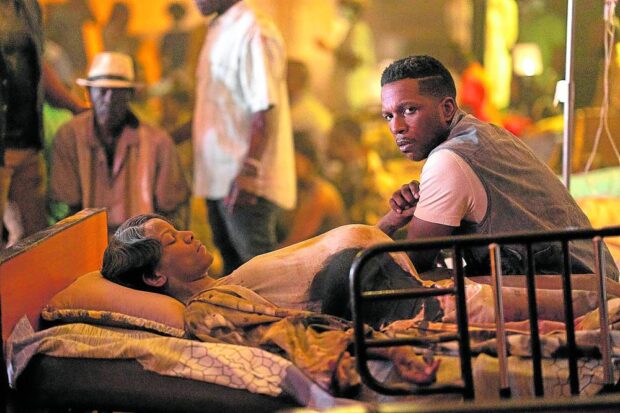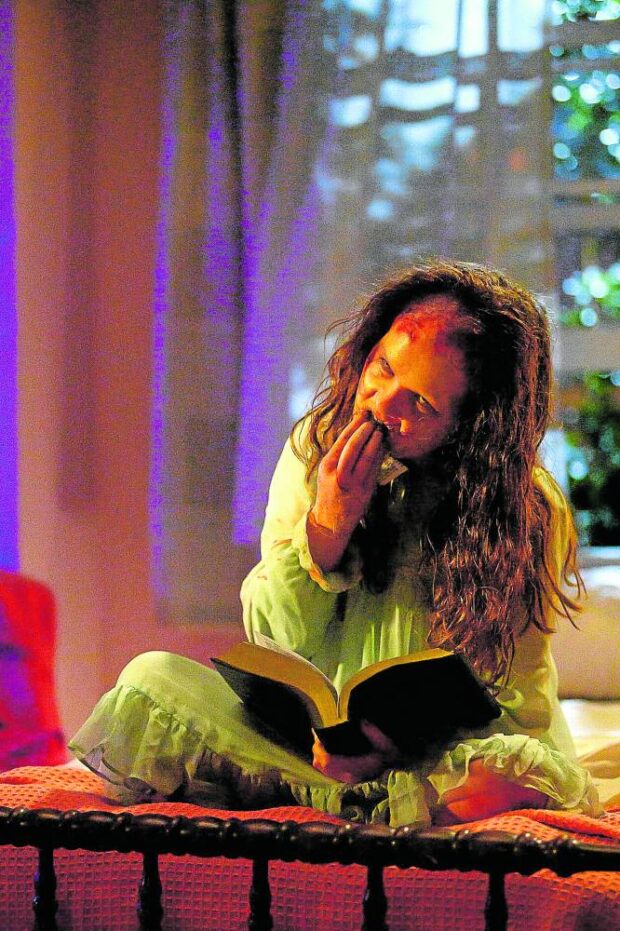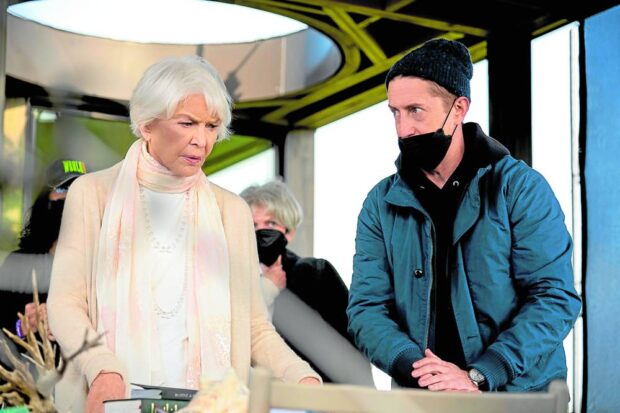How director convinced Ellen Burstyn to return to ‘Exorcist’ 50 years later

Fifty years after its groundbreaking release, William Friedkin’s “The Exorcist” is getting a contemporary redo by way of Universal Pictures’ “The Exorcist: Believer.”
The brand-new film, directed by David Gordon Green (the “Halloween” movies), is actually a direct sequel that sees retired actress Chris MacNeil (Oscar winner Ellen Burstyn)—now estranged from her daughter, Regan (Oscar nominee Linda Blair)—returning to the franchise to help single father Victor Fielding (Tony winner Leslie Odom Jr. of “Hamilton”) save his teenage daughter Angela (Lidya Jewett) and her best friend Katherine (Olivia O’Neill) from demonic possession.
“People still love ‘The Exorcist’ because it was never meant to be just fashionable,” said David when we spoke to him for this interview last Friday. “It was never a movie that dealt with cheap tricks or gimmicks. If you look at the movie closely, it isn’t really full of startling moments of any sort.
“For ‘Believer,’ we tried to emulate that and have a bit of ambiguity to our timeline. We did not lean into technology because we wanted our visual effects—from the makeup to the fire that was coming from the fireplace—to be done as practically as possible. We spent a lot of time trying to do everything for the film to feel grounded.
“Outside of a few visual and special effects, ‘The Exorcist’ has managed to withstand the test of time, like the head-spinning scene and its other iconic moments. If you watch it now, it feels like it could have been made yesterday—it’s just as effective as it was in 1973, in large part because it ignored the tropes of conventional horror filmmaking.”
Immersive experience
We watched the movie alone in a cold and dark preview room in Ortigas, and were creeped out of our wits—with good reason: “The Exorcist: Believer” is a clever fusion of formula, thespic passion and innovation. The original style obviously anchors the film but the execution and carefully limned expansion of its new story are nothing short of immersive.
The movie, which will have midnight screenings at 12:01 a.m. when it officially opens in Philippine theaters on Wednesday, expands its predecessor’s themes on shaken faith, family trauma and demonic possession.
The story hits the ground running soon after Angela and Katherine decide to skip school and vanish into the woods, only to return three days later with no memory of what happened to them!
When they return to their homes exhibiting strange behavior, Victor and Katherine’s parents, Tony (Norbert Leo Butz) and Miranda (Jennifer Nettles), are forced to accept the help offered by nun-turned-nurse Ann (Ann Dowd).
But Ann doesn’t just bring Ellen Burstyn’s character into the picture, she also helps arrange an interdenominational exorcism ritual that includes a reluctant Catholic priest, Father Maddox (EJ Bonilla), Pentecostal preacher Stuart (Danny McCarthy), root doctor Beehibe (Okwui Okpokwasili) and a Baptist pastor, Don Revans (Raphael Sbarge).
Asked why he decided to revisit “The Exorcist” 50 years after it was first released—and at a point in time when horror audiences have become so selective and savvy—David said he’s never been afraid to take on challenges.
Taking risks
“I like taking risks. I’ve never been afraid of risks in my career,” he stressed. “To take a title like ‘The Exorcist’—which is very meaningful to me as a film lover—is a tremendous opportunity that I don’t want to miss. It gives me a chance to weave something very personal in this movie.
“I don’t necessarily look at ‘The Exorcist: Believer’ as a horror movie—I call it a theological thriller. I want scary moments. I want an unnerving atmosphere that’s not necessarily falling into the conventions of the contemporary horror genre.”
Our Q&A with David:
What’s your recollection of watching “The Exorcist” for the first time? And how did that experience influence your storytelling approach for this direct sequel?
The most vivid memory I have from the first time I saw the film was the shot of 12-year-old Regan, played by Linda Blair, getting a spinal tap and you see the blood squirting out as they’re inserting the needle. It’s undoubtedly the most horrific moment of that movie!
In a way, it’s sequences like that one that gave me permission to not make a movie that feels so contemporary with its “fashionable” horror tropes. I wanted to lean into some of those awkward, painful and more cerebral clinical sequences.


I also love what director William Friedkin did with casting. He got real people in his movie, making it not feel like your average supernatural narrative. And so, if you see a priest in our film, chances are he’s a genuine priest. If you see a doctor, an EMT (emergency medical technician) or police officers at the end of the film, they’re probably playing themselves.
We cast authentic authority figures to come in and help us bring a believable and honest quality to our movie—and that’s very much inspired by sequences from Friedkin’s film.
There was an urban legend that “The Exorcist” had to endure a very difficult shoot because it was cursed—that many “cast and crew members were injured and some died, and unusual mishaps delayed the shoot.” Reportedly, the production took twice as long and cost almost three times the initial budget. The many mishaps led people to believe that the film was cursed. Weren’t you concerned that a similar fate could hurt you or compromise your career?
Oh, no (laughs)! I feel very protected by the spirits and the [positive] atmosphere around me, so I’m not too worried about that. You know, there’s a scene early on in our film where the Haitian voodoo priestess—who’s an authentic priestess—gave a blessing of protection to Victor’s unborn baby. But I also had her throw some of that [protective] energy my way, so I think I could put on my armor that way if needed.
Let’s talk about how you execute jump scares. Probably the most surprising one in “The Exorcist: Believer” is the scene involving the snake. After successes with your other horror films, has it become easier for you to know when to properly place the jump scare or execute them in a manner that viewers don’t expect?
For me, it’s always a consideration whether I should go for either surprise or suspense? That scene with the snake is an example of surprise being the more successful route, because you don’t want to know that there’s a snake. I mean, you don’t want to know when a bomb is about to go off, so you have to know how you’re going to structure that in an Alfred Hitchcock-type scene. If you do, then the payoff can be dynamite.
In the case of the snake, we wanted to do away with the music and just have it be quiet. We hear voices up above, so we’re focused on one thing. We’re looking at this necklace, this little pendulum that the character sees, so we’re distracting your eye. I guess the key to a great scare for me is distraction—you look over here, but then the scare is over there.
At the end of the movie, a compelling question is raised: What is evil? The answer that followed is very insightful. In your case, what’s evil for you?
I have to credit my cowriter Pete Sattler with that line. I remember reading it and thinking how profound it is. It’s also in the original novel that William Peter Blatty wrote. There are some brilliant passages about possession not just being in the demonic form, but also being in the little things that separate or divide us.


There’s always an enormous amount of tragedy that happens in the world every day. There are always headlines that are very disturbing. But for me, it’s destructive energies that one human being brings to another that I personally find most evil.
Lidya and Olivia’s performances hold this film together. Could you talk casting and working with them?
My audition process is always very extensive. After a couple of sessions with the casting director, who sees what their capabilities are, I then get into the room and make sure that they both have the improvisational qualities to be themselves.
They had to be able to bring the lightness of the role, particularly in the early parts of the film, as well as the emotional intensity required for the latter part of the story. I wanted to make sure they have strong families and support groups around them to help them pull that off safely.
We also had a child psychologist on set to help them navigate some very tricky environments emotionally. To be honest, Olivia and Lidya became the backbone of our film. The job entailed a lot of hard work for all of us, but seeing the girls’ smiles and hearing their laughter were really important to all of us.
I must say that the appearance of some familiar faces—like Ellen Burstyn, who’s now 90 years old—from the classic 1973 film instantly gives this story a measure of not just credibility, but also gravitas. How did you pitch this movie to them?
I was just trying to find a “connective tissue” that began with my passion for the film. I wanted to exert an effort to bring integrity to the franchise that a lot of people hadn’t seen since the original film. So, that was the idea: To make something from a personal perspective, to create something with meaning and value, then to invite them to collaborate with me.
Ellen Burstyn was the first phone call I made…so she could step into a role she hadn’t inhabited in 50 years. We spoke about things that were meaningful to her and what her version of the continuation of her character’s story might entail. INQ